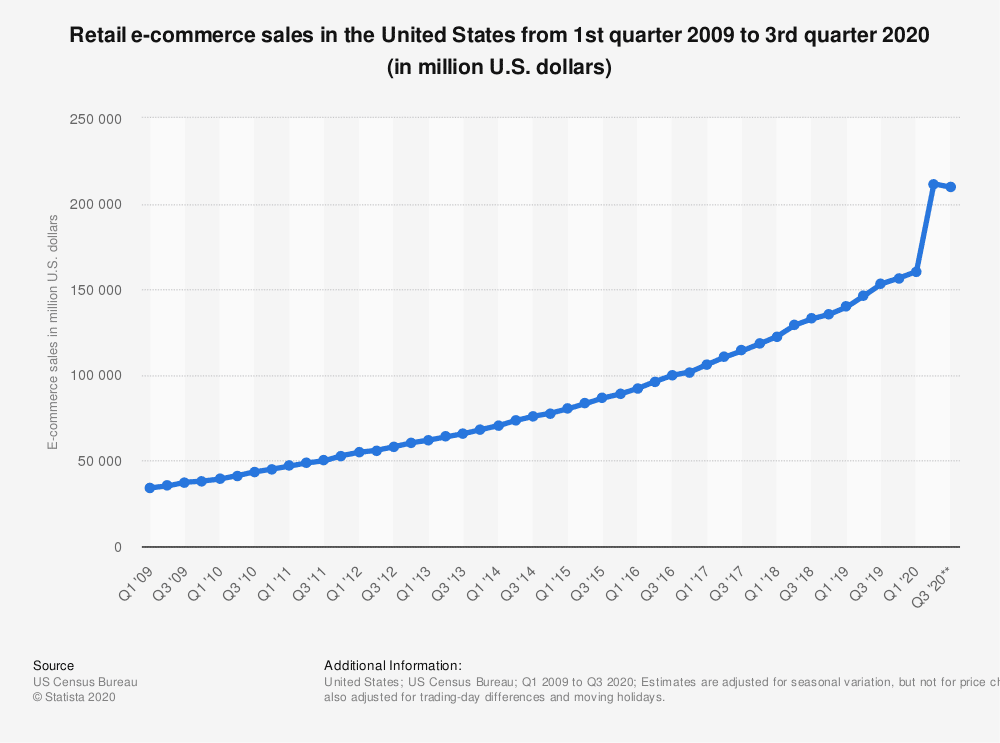Across the globe, businesses have had to adapt quickly to the many changes brought on by the explosion of digital-first businesses, especially those in the eCommerce space. In 2020, the international global eCommerce market exceeded $2 trillion, and it is expected to reach $6.54 trillion in 2022. The increasingly-popular video conferencing service Zoom had 12.92 million regular users in 2020. 55% of global businesses now offer some level of remote work capabilities, and 1 in 4 Americans are expected to work from home in 2021. Digital transformation has enabled organizations of all kinds to reach expansive audiences, connect with national and international talent, and conduct business faster and more efficiently. Embracing the technology that in enabling this tremendous growth can help small businesses flourish moving into 2021 and beyond.
The Shift to Digital in 2020
Over the last year, there has been an unprecedented shift towards digital commerce brought on by lockdown orders associated with the COVID-19 pandemic. The convenience and accessibility afforded by the internet have created a new demand for fast, easy online purchasing. 63% of online shoppers said they shop online because they can browse and select a wide range of products without necessarily having to visit multiple stores. Online shopping allows people to make their purchases without having to make time in their busy schedules to do so. The chart below illustrates the exponential increase in retail eCommerce sales in the United States over the last decade.
As of 2020, 26.28% of the world’s population were online shoppers, and 49.2% of eCommerce sales were made via mobile devices. Considering the fact that the desire for digital experiences is projected to continue to grow, businesses across industries need to adapt in order to remain connected with existing customers and continue to attract new ones. Accordingly, businesses of all sizes must be focused on and optimized for digital interactions with their customers moving into the future. The nature of a digital business is faster communication, fewer errors, and more efficient interactions with clients.
Many non-eCommerce businesses have also shifted operations to digital-first. Over the last five years, the number of people working from home has risen by 44%, and more employers are seeing the benefits of a digital workforce. The International Workplace Group found that 85% of businesses report that remote work options have made their companies more productive, and real estate expenses save per remote worker average $10,000 per year. Similarly, employees are reporting that they can work happily and efficiently from home and are able to strike healthy work-life balances. One study found that remote workers are 20-25% more productive than their on-site co-workers, and employee turnover is 25% lower amongst companies that offer remote work.
The Benefits of Becoming a Digital Business
Cost-efficiency
Transitioning into a digital-first business can save your company money. A brick-and-mortar store, for example, requires lighting, heating, maintenance, staffing, security systems, and countless other costs. Focusing your efforts on digital can also be extremely cost effective in the scope of potential clients you can reach. A digital marketing strategy can help get your products and services onto the social media feeds and Google searches of the people you want to reach, which can expand your client base and drive sales.
Some financial benefits of becoming a digital-first business include:
- Lower transaction costs
- Time and labor savings via automation
- Eliminated need for a brick-and-mortar location
- Lower inventory maintenance costs
- National and/or international sales
Safeguarding against unexpected outcomes
The COVID-19 pandemic has demonstrated the need for businesses to be prepared for anything. Many organizations that rely on in-person interactions have suffered greatly due to loss of revenue and the new demand for fast and efficient delivery of goods and services. This has underscored the security that operating a digital-first company affords. Many organizations were caught off guard and even had to lay off employees because they were unable to shift operations to a digital space quickly. Integrating remote work software into your business can ensure that you are prepared for anything and that your employees can work productively from anywhere. The flexibility this affords workers will encourage loyalty to your organization and lead to an overall happier workforce.
Improved customer experience
According to Gartner, 91% of organizations are currently engaged in some form of digital initiative. The demand for goods and services that can be accessed via the internet is undeniable. The ability to order products for home delivery with only a one- or two-day wait has changed the way people do business permanently. Consumers have come to expect this level of convenience from the companies they patronize.
The internet affords customers virtually countless options. In the same way, it enables businesses to connect with more customers and potential employees outside of their local regions. It also enabled them to build loyalty through instant communication via social media and email marketing. Becoming a digital-first business is a critical way to stay competitive in an increasingly internet-dependent world and provide the most cutting-edge services to customers and work environments to employees.
Define Your Digital Goals and Ambitions
Once you have decided to pivot to digital-first, you will want to identify your goals. Do you want to reach new customers and employees on a national or even international scale? Is your objective to increase market share or expansion? Consider the ways that operating a digital business can help your organization grow and make a plan for achieving those goals.
Use Analytics and Data
Determine your target demographic’s new needs
During the pandemic, your business likely acquired new customers in search of digitally-accessible and deliverable products and services. Understanding how these new customers found your website and why they continue to come back and purchase again can offer useful insight into how you can continue to acquire customers from new demographics. Customer analytics tools can help you to learn about your new customer base and what your brand has to offer that is driving new revenue. A digital marketing service can outfit your business with the technology needed to collect this data and learn about your new customers.
Plan to serve existing needs in a new way
Digital transformation does not mean that you can’t keep your existing customer base. Encourage customers to sign up for an email or newsletter list, for example, and be transparent with them about your new goals and plans for your company. Highlight the ways that digital tools can help you serve their needs even more effectively. Consumer expectations have changed drastically, and your customers likely expect you to be able to provide the service they expect in a way that is competitive with others in your industry.
Embrace eCommerce and Digital Transformation
Adapt your marketing strategy
Shifting to digital-first means the way you attract new business will have to change, too. There are 4.66 billion active internet users as of 2020, which encompasses 59% of the global population. The same way people are searching for products online, they are also looking for the services they need. For example, 72% of people use the internet to find healthcare services, and 69% of patients are regularly using telehealth services. It is now more important than ever for service-based businesses, such as doctors, auto repair shops, and accountants, to engage with digital tools in order to generate new business.
Develop your website and online store
It takes about 50 milliseconds for a potential customer to form an opinion about your website that determines whether they will stay or leave. The same way you want to present yourself professionally when conducting in-person business, your website should reflect a positive image of your business. The following are some key attributes of a successful website:
- Fast load times
- Easy navigation and checkout
- Appealing design
- Clear imagery and descriptions
- Customer support
- Effective calls to action
- Offers and deals
A digital marketing firm can help you develop a website that is thoughtfully built and user-friendly, which will encourage new customers to interact with your business.
Embrace social media
In 2020, 3.6 billion people were using social media worldwide. This number is projected to reach 4.41 billion by 2025. Strategically placing your marketing materials on various social media channels can help you reach the customers you are looking for based on demographic information. It is also a great way to build your brand image and engage with your customers, which can encourage loyalty and drive website traffic. Social media also enables users to post reviews for your business. 94% of online shoppers reported that a negative review has convinced them to avoid patronizing a business, so encourage customers with whom you have had positive interactions to leave a review on your Facebook page.
Consider offering flexible shipping options
One study found that 72% of consumers cite free shipping as their top reason to shop online. People have come to expect fast, trackable shipping options that are either low-cost or free of charge due to standards set by large corporations like Amazon. Consider working with a third-party shipping and logistics service. This can enable you to offer affordable shipping options and a streamlined logistics process for your business that saves you costs associated with time and labor.
Switch to Digital Advertising
Benefits of Digital vs. Traditional Advertising
Once you decide to become a digital-first business, you’ll need to develop a digital marketing strategy that makes use of technology to help attract new business and establish credibility for your online store. Traditional marketing methods include:
- Radio and television commercials
- Magazine and newspaper ads
- Billboards
- Direct mail
- Telemarketing
While these forms of marketing have been effective in the past, people now turn to an internet search. Email marketing has an average return on investment of $44 for every $1 spent. 93% of online experiences begin with a search engine, meaning your website must be optimized for search. PPC ads have a ROI rate of 200%. Digital marketing allows organizations to identify and focus on the specific marketing methods that are working best for them. Benefits of digital marketing include:
- Cost efficiency
- Measurable ROI
- Interaction with your audience
- High conversion rates
Choose Your Ad Platform
When choosing your digital marketing ad platform, there are a few important factors to consider. What is your target demographic for customers and employees? Where are they most likely to spend their time on the internet? Beyond that, what are your specific objectives? Perhaps you need to increase traffic to your website and stay within a budget. Choosing an ad platform that provides tools for increasing website visits and is cost efficient, like Google Ads, might be the best choice for you. Consult the chart below for a comparison of some popular ad platforms.
The Future of Digital-first Business
2020 was a record year in terms of online sales and growth of digital business worldwide. According to Deloitte, 55% of Millennials and 56% of Gen Xers actually prefer online shopping to physical stores. The convenience and access to a wider range of services afforded by the internet are expected to continue to affect consumer behaviors moving into the future. Accordingly, it is crucial that organizations across industries adapt and evolve to serve new demand. Businesses must be able to provide the most efficient and up-to-date services and flexible remote work options possible.
Contact Us
If you are looking to shift to digital-first and are in need of digital marketing services, contact Dragonfly Digital Marketing today. We can help you achieve your goals and make use of technology to increase sales, grow your business, and thrive in a digital environment.



